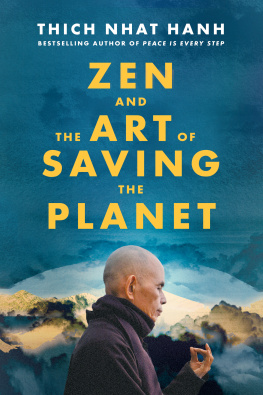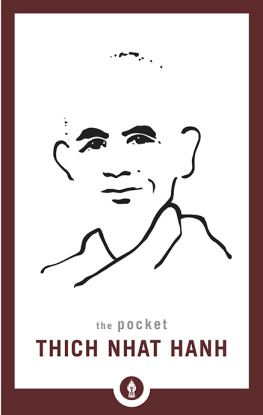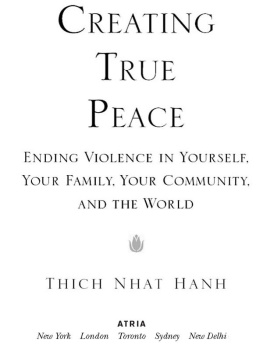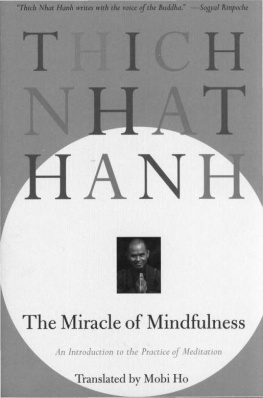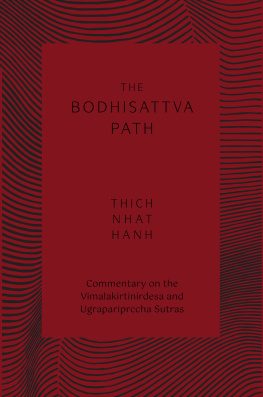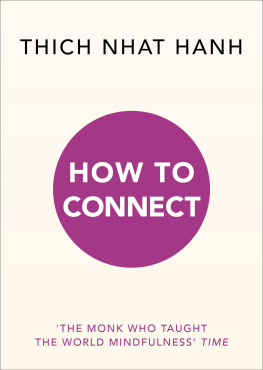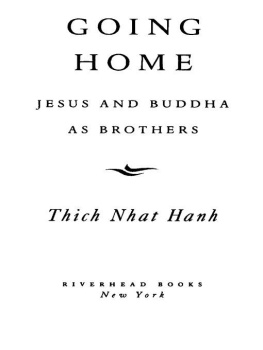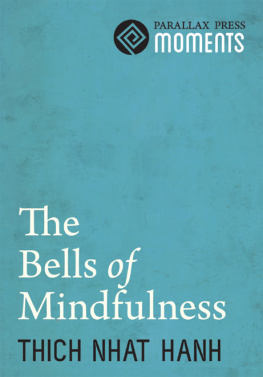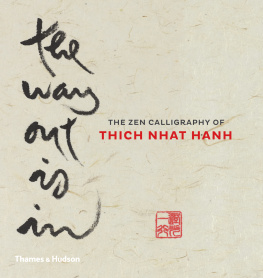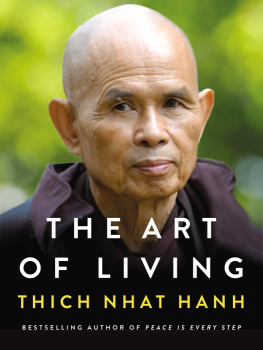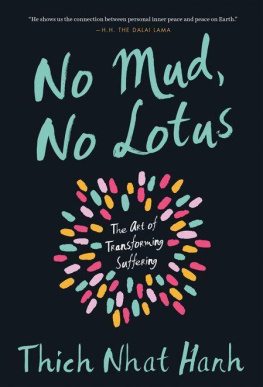Contents
Guide
Contents
Sister True Dedication
Thich Nhat Hanh (or Thay, as we call him) is a poet, scholar, peace activist, Zen masterand man of action. He embodies an inspiring, decisive, compassionate, and fearless engagement that springs from a place of serenity and insight. Thay teaches that to practice meditation is to look deeply into the heart of reality, to see things that others cant see. And, as he says, Once there is seeing, there must be acting. Otherwise, whats the use of seeing?
A monk for nearly eighty years, Thay has found remarkable ways to combine his practice of meditation and mindfulness with extraordinary actions for peace and social justice, investing his life energy in training the next generation of engaged Buddhists, and building healthy communities of mindful living that can continue to be catalysts for change in the world.
In the 1960s, Thay created a movement of thousands of young social workers in Vietnam before leaving for the West to call for peace. A leading voice for nonviolent social change, he collaborated with Dr. Martin Luther King Jr., with whom he shared a vision for building a beloved community that could transcend division, discrimination, and hatreda community in which true reconciliation can be possible, among all people and among all nations. In the 1970s, together with friends and colleagues, Thay rescued boat people from the high seas off Singapore and initiated one of the very first international environmental conferences in Europe. Over the following decades, Thay created a way of teaching and applying mindfulness in everyday life that could be accessible to millions. He has shared his vision for compassionate leadership with politicians, businesspeople, teachers, activists, and more recently, Silicon Valley CEOs. And from his directand often painfulpersonal experience of unstable and polarized times, he has developed a simple yet powerful code of global ethics that offers a bright compass to guide our way forward.
In this very moment, we face a potent intersection of crises: ecological destruction, climate breakdown, rising inequality, exploitation, racial injustice, and the lasting impacts of a devastating pandemic. The situation is beyond urgent. In order to face these challenges with the best weve got, we need to find ways to strengthen our clarity, compassion, and courage. Cultivating a strong training in meditation and mindfulness is not an opiate to escape whats going on but a way for us to truly still the mind and look deeply, in order to see ourselves and the world clearly. From this foundation of clarity and insight well be able to take the most appropriate, effective action to transform the situation and create a regenerative culture in which all life is respected.
Thay tells us that the world doesnt need another ideology or doctrine, but the kind of awakening that can restore our spiritual strength. This book, edited by his students, offers his most inspirational and timely teachings for the next generation and his guidance on how we can truly sustain our efforts to help our society and planet without burning out. Thay first asked us to begin working on this book almost a decade ago, and we are excited to have finally assembled in one volume his powerful Zen teachings on deep ecology, engaged action, community-building, and collective awakening, drawn from his writing, talks, interviews, and question-and-answer sessions. Thay gives voice to a very practical, everyday ethic that can guide our decisions and actions, transform the everyday habits that hold us back, and help us touch joy and meaning right in the heart of each moment. Thay explains that without such an ethicwithout a spiritual dimension to guide our daily liveswe will lose everything.
Before Thay suffered a major stroke in 2014, many of us who lived and trained with him had a chance to experience his guidance directly. He nurtured and challenged us, encouraged and sometimes scolded us. He was tender as a grandfather, fierce as a warrior. There were times he mobilized us to be some of his many arms of engaged action in the world. And, whatever the task, it was always to be done with direct immediacy. (I learned that a young student should never ask her teacher, Are you sure?) In true Zen style, there were moments when Thay declared, Dont just do something, sit there! At other moments, hed call our names and send us off from our cushions, out of the meditation hall, to work on something urgent wed not yet finished. There were days when the action was so pressing hed remind us, with a gentle smile and a glint in his eye, that theres no need to eat lunch. The human body can survive several days without food. And there were yet other days when, seeing us working so hard wed forgotten to eat, he quietly went into the kitchen himself to prepare us hot soup for dinner.
It is hard to put into words Thays compassion and light and his bright, penetrating gaze. It is hard to express his gentleness and warmth. It is hard to explain how much love and trust he offers unconditionally to all those who consider themselves his students. Thay encourages us to boldly reimagine an entirely new way of living and doing things, and to never be afraid to dream. And he reminds us, no matter what, to always work together, never alone. As companions on the path, we invite you to join us on a journey to the heart of his teachings on Zen and the Art of Saving the Planet.
I have been looking for you, my child,
Since the time when rivers and mountains still lay in obscurity.
I was looking for you when you were still in a deep sleep,
Although the conch had many times
Echoed in the ten directions.
From our ancient mountain I looked at distant lands
And recognized your steps on so many different paths.
Where are you going?
In former lifetimes you have often taken my hand
And we have enjoyed walking together.
We have sat for long hours at the foot of old pine trees.
We have stood side by side in silence
Listening to the sound of the wind softly calling us
And looking up at the white clouds floating by.
You have picked up and given to me the first red autumn leaf
And I have taken you through forests deep in snow.
But wherever we go, we always return to our
Ancient mountain to be near to the moon and stars,
To invite the great bell every morning to sound,
And help all beings to wake up.
FROM AT THE EDGE OF THE FOREST
by Thich Nhat Hanh
The beauty of the Earth is a bell of mindfulness. If you cant see it, you must ask yourself why. Maybe something is blocking the way. Or maybe you are so busy looking for something else you cant hear the call of the Earth.
Mother Earth is saying, My child, Im here for you; Im offering all this for you. Its true: the rays of sunshine, the singing birds, clear streams, the cherry blossom in spring, and the beauty of the four seasonsits all there for you. And, if you cant see or hear it, its because your mind is too full.
The Earth is telling you that she is there and that she loves you. Every flower is a smile of the Earth. Shes smiling to you, and you dont want to smile back. The fruit in your handit might be an orange or a kiwiis a gift from the Earth. But, if you dont feel thankful, its because youre not there for the Earth, for life.

